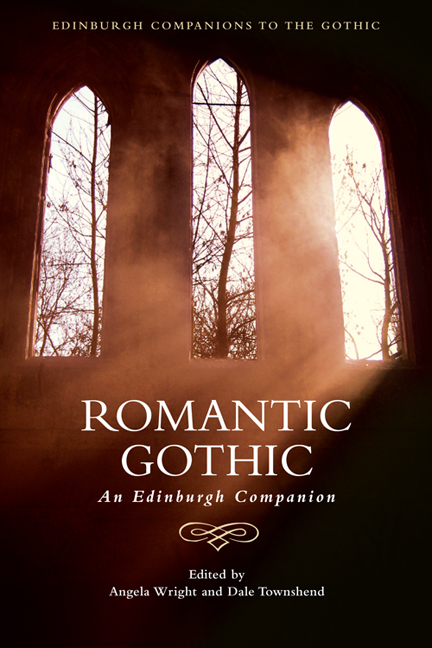Book contents
- Frontmatter
- Contents
- 1 Gothic and Romantic: An Historical Overview
- Part I Gothic Modes and Forms
- Part II National and International Borders
- 11 Gothic Borders: Scotland, Ireland and Wales
- 12 Gothic Travels
- 13 The Romantic and the Gothic in Europe: The Elementary Spirits in France and Germany as a Vehicle for the Transmission and Development of the Fantastique, 1772–1835
- 14 American Gothic Passages
- Part III Reading the Romantic Gothic
- Notes on Contributors
- Index
12 - Gothic Travels
from Part II - National and International Borders
Published online by Cambridge University Press: 05 August 2016
- Frontmatter
- Contents
- 1 Gothic and Romantic: An Historical Overview
- Part I Gothic Modes and Forms
- Part II National and International Borders
- 11 Gothic Borders: Scotland, Ireland and Wales
- 12 Gothic Travels
- 13 The Romantic and the Gothic in Europe: The Elementary Spirits in France and Germany as a Vehicle for the Transmission and Development of the Fantastique, 1772–1835
- 14 American Gothic Passages
- Part III Reading the Romantic Gothic
- Notes on Contributors
- Index
Summary
Ever since early reviewers of Ann Radcliffe suggested that her descriptions appeared ‘to be drawn from personal examination’ (Anon. in Rogers 1994: 5), the writing and experience of travel has been an important critical context for Gothic fiction in the Romantic and pre-Romantic periods. Published travelogues are frequently noted as a resource for novelists, providing descriptive set pieces through which to convey settings that are politically and ideologically, as well as geographically, distant and distinct from the contemporary British present (Chard 1986: xix; Davison 2009: 93; Norton 1999: 73). At the same time, travel has been recognised as a characteristic feature of a certain kind of Gothic narrative, in which novelists re-present (accurately or otherwise) the experience of contemporary travel (Moers 1976: 127–8; Bohls and Duncan 2005: xxi; Dekker 2005: 71). Implicit in these connections is a more significant relationship between Gothic and travel-writing: one that enables the interpolation of scenic detail or recognisable experiences, but simultaneously reveals this process to be a more profound feature of the Gothic's place in a contemporary cultural imagination. During the eighteenth century and Romantic period, Gothic novels and travelogues coexisted within a wider print culture. Publishers of Gothic fiction were often also publishers of printed tours, while, by the same token, readers of Gothic fiction were frequently readers of travel narratives. By producing porous texts that incorporated and re-imagined material from contemporary travelogues, Gothic novelists asserted the adjacency of their work within this marketplace; they appealed to the ‘discriminating readers’ of a ‘high status’ genre (Watt 1999: 112–3) that was itself a ‘quintessential enlightenment production’ (Davison 2009: 93). What this means is that travel-writing could locate the Gothic culturally, and not only geographically. The history of this process is a key strand in the Gothic's development.
This chapter surveys the way in which two predominant forms of pre-Romantic and Romantic travel-writing – that is, the literatures of the Grand Tour and Picturesque domestic tourism – responded to the Gothic. It then considers how Gothic novelists incorporated and revised such strategies in the Romantic period, using Ann Radcliffe as an exemplary case study.
- Type
- Chapter
- Information
- Romantic GothicAn Edinburgh Companion, pp. 224 - 246Publisher: Edinburgh University PressPrint publication year: 2015

